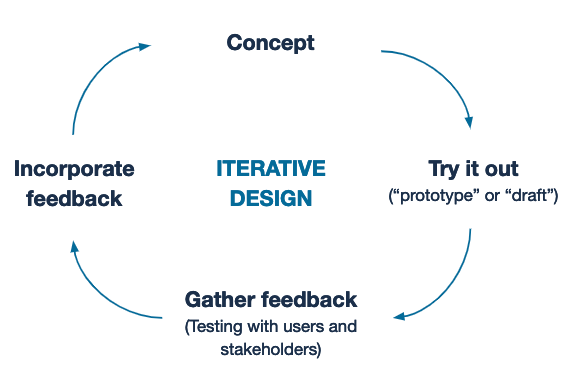Defining design
We see design as a process of intentionally deciding, over and over, how interactions and systems should work for people, based on research.
Design is a series of intentional decisions
Every project is shaped by a series of decisions, whether those decisions are about meeting agendas, research plans, how people are engaged in the process, what constitutes a minimum-viable product, or how a technical solution is supported within the wider organization. Taking a design approach means both identifying opportunities for decision-making, and also being intentional about decision-making.
Design impacts equity and inclusion
Most research focuses on the mindsets, behaviors and experiences of people and groups. There are times when you need to look broadly at the system and structures that fail to serve communities equitably, rather than focusing solely on the community or individual. To create equitable and inclusive products, it is important to move beyond understanding an individual participants’ experience to the broader system they interact with and the barriers they face.
Design depends on context
What’s the right approach? It depends. We use design research to better understand the problems we might solve, the systems those problems connect to, and what the opportunities for technical and service changes are. We actively validate the success of our solutions with people through ongoing and iterative design research.
Design supports people's needs
We proactively engage with people to understand their needs and determine how well our decisions have met those needs. Since some of our work involves creating solutions that are used, managed, delivered, or informed by government employees or partner organizations, who we engage in the work may not always be just members of the public.
Stakeholders are anyone with a legitimate interest in what we’re designing. Stakeholders include our agency partners and the people they serve—that is, their constituents. We regularly collaborate with our agency partners, and while all design processes must take their needs into consideration, our process ultimately puts those most impacted by our work at the center of our decision-making as our primary concern.
Design should be cross-functional
When design is practiced together, it creates shared understanding. We bring together cross-functional teams, including a range of different types of designers, to arrive at more well-informed, less biased decisions. Outside of the range of methodologies that come from different design approaches, cross-functional teams allow for two kinds of thinking:
- Divergent thinking helps us to identify opportunities for decision making, and to explore possible choices
- Convergent thinking helps us narrow our choices, and follow through on our decisions
Intentionally transitioning between divergence and convergence helps make the decision-making process visible and participatory for team members.
Design shapes organizations and vice-versa
Products and services impose requirements on the organizations that support them, and vice-versa. We shouldn't design an agency’s homepage to include images on every news post, for example, if we haven’t yet made certain that the agency can reasonably source images for each of its news posts. To best support the endeavor as a whole, we want to proactively acknowledge when our work may require nw investments, organizational shifts or new resources.
Design is never done
We don’t have all the answers. And that’s okay. We take an iterative, cyclical, participatory, lean approach. We try things out and learn from them. We commit to continuous improvement using critiques, wireframes, prototypes, usability tests, service blueprints, etc. and we strive to build the capacity of our partners to do the same.

Additional resources
- What is design? presentation
- Design 101 presentation

 User Experience Design Guide
User Experience Design Guide